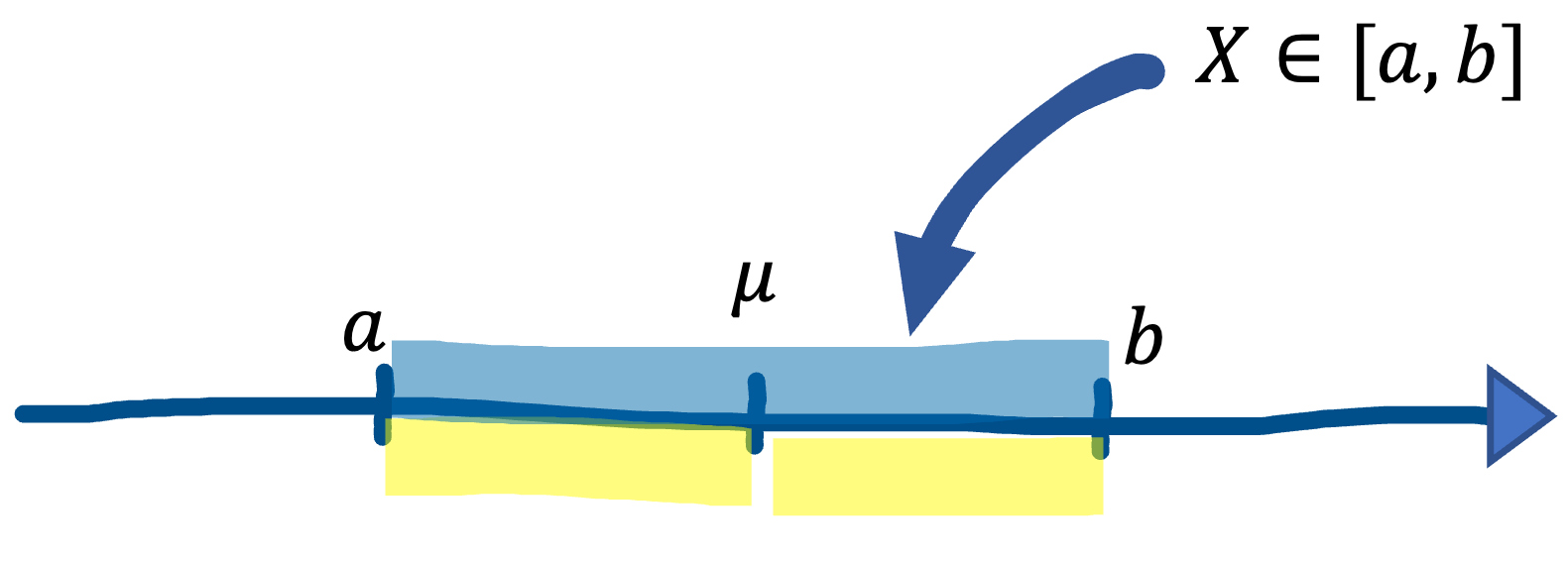With the notion of the tilting and its connection to the relative entropy introduced in this post, we will see the entropy method in this post. As described in this post, when a random raviable $Z$ satisfies \[ \psi_{Z - \mathop{\mathbb{E}}\left \lbrack Z \right \rbrack }(\lambda) \leq \frac{ \lambda^{2}}{2} v \ \ \forall \lambda \gt 0, \label{eq:1}\tag{1} \] $Z$ is sub-Gaussian and concentrated around its mean as \[ \mathbb{P}\{ |Z - \mathop{\mathbb{E}} \left \lbrack Z \right \rbrack | \leq t\} \leq \exp( -\frac{t^{2}}{2 v}) \ \ \forall t \gt 0. \label{eq:2}\tag{2} \] where $ \psi_{Z - \mathop{\mathbb{E}}\left \lbrack Z \right \rbrack }(\lambda) = \log \mathop{\mathbb{E}} \exp \left (\lambda (Z - \mathop{\mathbb{E}} \left \lbrack Z \right \rbrack) \right ) $ is the logarithm of the moment generating function. Instead of directly bounding $\psi_{Z - \mathop{\mathbb{E}}\left \lbrack Z \right \rbrack }(\lambda)$, entropy method bounds $ \frac{1}{\lambda^{2}} \frac {\text{Ent}(e^{\lambda Z})} {\mathop{\mathbb{E}} \left \lbrack e^{\lambda Z} \right \rbrack }, $ which is equivalent to the divergence caused by the tilting of $ \frac{e^{\lambda Z}}{\mathbb{E} e^{\lambda Z}}, $ $ \frac{1}{\lambda^{2}} D(P_{\frac{e^{\lambda Z}}{\mathbb{E} e^{\lambda Z}}} \parallel P) $. What brings this connection is Herbst’s argument.
Herbst’s argument
To show $ \psi(\lambda) \leq \frac{ \lambda^{2}}{2} v \ \ \forall \lambda \gt 0 $ is equivalent to showing \[ \Leftrightarrow \frac{\psi(\lambda)}{\lambda} \leq \frac{ \lambda}{2} v \Leftrightarrow \color{green}{ \frac{d}{d \lambda} \left ( \frac{\psi(\lambda)}{\lambda} \right ) } \leq \frac{v}{2}, \] and we focus on $ \frac{d}{d \lambda} \left ( \frac{\psi(\lambda)}{\lambda} \right ). $ \[ \color{green}{ \frac{d}{d \lambda} \left ( \frac{\psi(\lambda)}{\lambda} \right ) } = \frac{d}{d \lambda} \left ( \frac{1}{\lambda} \log \mathbb{E} e^{ \lambda (Z - \mathop{\mathbb{E}} \left \lbrack Z \right \rbrack) } \right ) = \frac{d}{d \lambda} \left ( \frac{1}{\lambda} \left ( \log \mathbb{E} e^{ \lambda Z} - \lambda \mathbb{E}\left \lbrack Z \right \rbrack \right ) \right ). \] Since $𝔼[Z]$ is constant, the above is \[ \frac{d}{d \lambda} \left ( \frac{1}{\lambda} \left ( \log \mathbb{E} e^{ \lambda Z} \right ) \right ) = \frac{1}{\lambda^{2}} \left ( \frac{\mathbb{E} \left \lbrack Z e^{\lambda Z} \right \rbrack } {\mathbb{E} \left \lbrack e^{\lambda Z} \right \rbrack } - \log \mathbb{E} e^{ \lambda Z} \cdot 1 \right ) = \frac{1}{\lambda^{2} \mathbb{E} \left \lbrack e^{\lambda Z} \right \rbrack } \left ( \color{blue}{ \lambda \mathbb{E} \left \lbrack Z e^{\lambda Z} \right \rbrack } - \mathbb{E} \left \lbrack e^{\lambda Z} \right \rbrack \cdot \log \mathbb{E} e^{ \lambda Z} \right ). \] Note that \[ \color{blue}{ \lambda \mathbb{E} \left \lbrack Z e^{\lambda Z} \right \rbrack } = \mathbb{E} \left \lbrack \lambda Z e^{\lambda Z} \right \rbrack = \mathbb{E} \left \lbrack e^{\lambda Z} \lambda Z \right \rbrack = \mathbb{E} \left \lbrack e^{\lambda Z} \log e^{\lambda Z} \right \rbrack . \] Recall $ \text{Ent}(X) := \mathbb{E} \left \lbrack X \log X \right \rbrack - \mathbb{E} \left \lbrack X \right \rbrack \log \mathbb{E} \left \lbrack X \right \rbrack $, we obtain \[ \color{green}{ \frac{d}{d \lambda} \left ( \frac{\psi(\lambda)}{\lambda} \right ) } = \frac {\text{Ent} (e^{\lambda Z})} { \lambda^{2} \mathbb{E} \left \lbrack e^{\lambda Z} \right \rbrack } = \frac{1}{\lambda^{2}} D(Q \parallel P), \ \ Q = P_{ \frac {e^{\lambda Z}} {\mathop{\mathbb{E}} \left \lbrack e^{\lambda Z} \right \rbrack } }. \] Thus, Herbst’s argument says that if the exponential tilting based on $Z$ is less than $ \frac{\lambda^{2}}{2}v $ for all $\lambda \gt 0$, then Eq.$\,$($\ref{eq:1}$) and thus Eq.$\,$($\ref{eq:2}$) holds for such $Z$, meaning $Z$ is sub-Gaussian.
Deriving Hoeffding’s inequality by Herbst’s argument
Hoeffding’s lemma states that if $X \in [a,b]$, then $X$ is $\frac{(b-a)^{2}}{4}$-sub-Gaussian.
Preparation
We know that $X \in [a,b]$ satisfies
$
|X - \mu| \leq \frac{b-a}{2}
$
as
 where the length of yellow regions is $\frac{b-a}{2}$.
Letting $Y = X - \mu$, since $\text{Var}$ is invariant to the transition,
\[
\text{Var}(X) = \text{Var}(Y)
=
\mathbb{E} \left \lbrack Y^{2} \right \rbrack - (\mathbb{E} Y)^{2}.
\]
As $\mathbb{E} Y = 0$, the above is
\[
= \mathbb{E} \left \lbrack Y^{2} \right \rbrack
\leq
\mathbb{E} \left \lbrack
\left (
\frac{b-a}{2}
\right )
\right \rbrack^{2}
=
\left (
\frac{b-a}{2}
\right )
^{2},
\]
and thus we have
\[
\text{Var}(X) \leq \frac{(b-a)^{2}}{4}.
\label{eq:3}\tag{3}
\]
where the length of yellow regions is $\frac{b-a}{2}$.
Letting $Y = X - \mu$, since $\text{Var}$ is invariant to the transition,
\[
\text{Var}(X) = \text{Var}(Y)
=
\mathbb{E} \left \lbrack Y^{2} \right \rbrack - (\mathbb{E} Y)^{2}.
\]
As $\mathbb{E} Y = 0$, the above is
\[
= \mathbb{E} \left \lbrack Y^{2} \right \rbrack
\leq
\mathbb{E} \left \lbrack
\left (
\frac{b-a}{2}
\right )
\right \rbrack^{2}
=
\left (
\frac{b-a}{2}
\right )
^{2},
\]
and thus we have
\[
\text{Var}(X) \leq \frac{(b-a)^{2}}{4}.
\label{eq:3}\tag{3}
\]
Proof 1
The first way is the one uses the fact we saw in this post, $ \psi_{X}’'(\lambda) = \text{Var}_Q(X) $. Eq.$\,$($\ref{eq:3}$) holds no matter what the measure is and thus in other words, it is valid no matter how the measure $P$ is tilted. So we have \[ \psi_{X}’'(\lambda) = \text{Var}_Q(X) = \text{Var}(X) \leq \frac{(b-a)^{2}}{4}, \] indicating \[ \psi_{X}(\lambda ) \leq \frac{\lambda^{2}}{2} \frac{(b-a)^{2}}{4}, \] and thus we obtain the states of Hoeffding’s lemma.
Proof 2
We show alternative proof using Herbst’s argument. Herbst’s argument says \[ \frac {\text{Ent} (e^{\lambda X})} { \mathbb{E} \left \lbrack e^{\lambda X} \right \rbrack } = \lambda^{2} \color{green}{ \frac{d}{d \lambda} \left ( \frac{\psi(\lambda)}{\lambda} \right ) } = \lambda^{2} \left ( \psi’(\lambda) \frac{1}{\lambda} - \psi(\lambda) \frac{1}{\lambda^{2}} \right ) = \lambda \psi’(\lambda) - \psi(\lambda), \] and the RHS can be written as \[ \lambda \psi’(\lambda) - \psi(\lambda) = \int_{0}^{\lambda} \theta \ \psi’'(\theta) d \theta = \int_{0}^{\lambda} \theta \ \text{Var}_Q(X) d \theta \] Using Eq.$\,$($\ref{eq:3}$) like in the proof 1, the above is bounded as \[ \leq \int_{0}^{\lambda} \theta \ \frac{(b-a)^{2}}{4} d \theta = \frac{(b-a)^{2}}{4} \frac{\theta^{2}}{2} \bigg\rvert_{0}^{\lambda} = \frac{\lambda^{2}}{2} \frac{(b-a)^{2}}{4}. \] It indicates \[ \frac {\text{Ent} (e^{\lambda X})} { \mathbb{E} \left \lbrack e^{\lambda X} \right \rbrack } \leq \frac{\lambda^{2}}{2} \frac{(b-a)^{2}}{4}, \] which is equivalent to indicating \[ \psi_{X}(\lambda ) \leq \frac{\lambda^{2}}{2} \frac{(b-a)^{2}}{4}, \] because of Herbst’s argument. It shows $\frac{(b-a)^{2}}{4}$-sub-Gaussianity, and Hoeffding’s lemma has been proven.